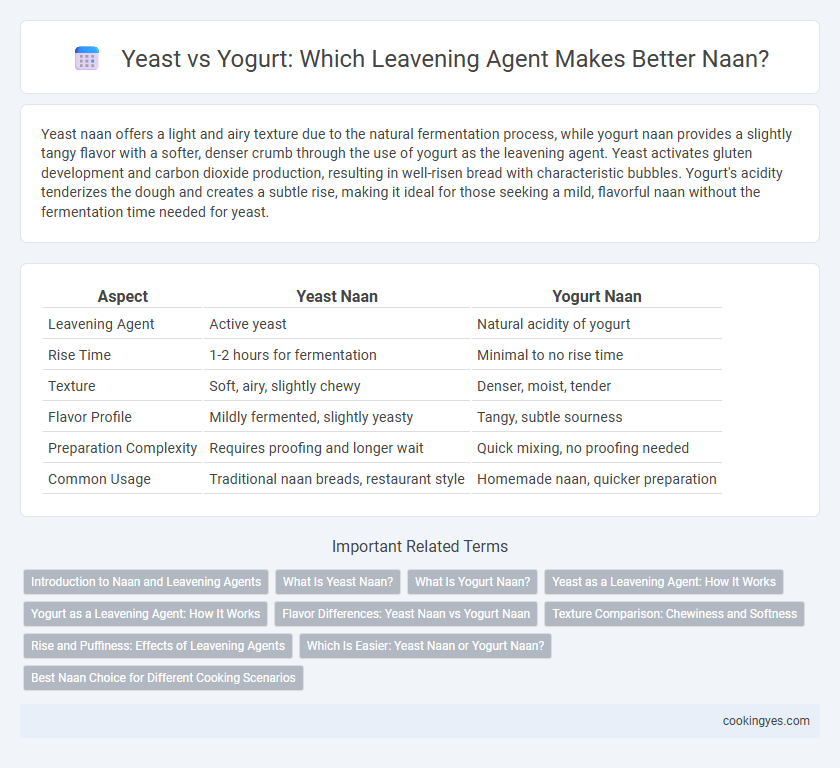Yeast naan offers a light and airy texture due to the natural fermentation process, while yogurt naan provides a slightly tangy flavor with a softer, denser crumb through the use of yogurt as the leavening agent. Yeast activates gluten development and carbon dioxide production, resulting in well-risen bread with characteristic bubbles. Yogurt's acidity tenderizes the dough and creates a subtle rise, making it ideal for those seeking a mild, flavorful naan without the fermentation time needed for yeast.
Table of Comparison
| Aspect | Yeast Naan | Yogurt Naan |
|---|---|---|
| Leavening Agent | Active yeast | Natural acidity of yogurt |
| Rise Time | 1-2 hours for fermentation | Minimal to no rise time |
| Texture | Soft, airy, slightly chewy | Denser, moist, tender |
| Flavor Profile | Mildly fermented, slightly yeasty | Tangy, subtle sourness |
| Preparation Complexity | Requires proofing and longer wait | Quick mixing, no proofing needed |
| Common Usage | Traditional naan breads, restaurant style | Homemade naan, quicker preparation |
Introduction to Naan and Leavening Agents
Naan, a traditional South Asian flatbread, relies on leavening agents to achieve its soft and airy texture. Yeast naan uses active yeast, which ferments the dough, creating air pockets and a slightly tangy flavor, while yogurt naan incorporates yogurt as a natural leavening agent, providing mild acidity and tenderness without the need for fermentation. Understanding the differences in leavening agents helps in selecting the right naan for specific cooking times and flavor profiles.
What Is Yeast Naan?
Yeast naan is a traditional Indian flatbread leavened using yeast, which creates a light and airy texture with characteristic bubbles and a slightly tangy flavor. The fermentation process with yeast allows the dough to rise slowly, resulting in a soft and chewy consistency that is distinct from yogurt naan. Unlike yogurt naan, which relies on the acidity of yogurt for leavening, yeast naan develops a more pronounced volume and a complex taste due to the yeast activity.
What Is Yogurt Naan?
Yogurt Naan uses yogurt as a natural leavening agent, which contributes to its soft texture and slightly tangy flavor. Unlike yeast naan that relies on fermentation time for rising, yogurt naan leverages the acidity and probiotics in yogurt to create a tender and mildly sour bread. This method results in quicker preparation while maintaining the traditional fluffy and delicious characteristics of naan.
Yeast as a Leavening Agent: How It Works
Yeast naan relies on the fermentation process where yeast consumes sugars and produces carbon dioxide, causing the dough to rise and develop a light, airy texture. This biological leavening agent enhances the naan's flavor complexity through natural fermentation, resulting in a slightly tangy taste and soft crumb structure. In contrast, yogurt naan leavens primarily through the acidity of yogurt interacting with baking soda, producing carbon dioxide without the extended fermentation and flavor development yeast provides.
Yogurt as a Leavening Agent: How It Works
Yogurt acts as a natural leavening agent in Naan by providing acidity that reacts with baking soda or baking powder, producing carbon dioxide bubbles that make the dough rise and become soft and fluffy. The live cultures in yogurt also help tenderize the dough, enhancing its texture and flavor without the need for yeast fermentation. This method allows for quicker preparation time compared to yeast Naan, while still delivering a light and airy result.
Flavor Differences: Yeast Naan vs Yogurt Naan
Yeast naan develops a distinctive, slightly tangy flavor due to the fermentation process, providing a light and airy texture with subtle complexity. Yogurt naan offers a mild tartness and creamy richness, resulting from the lactic acid in yogurt, which imparts a softer crumb and a more tender bite. The flavor profile of yeast naan is more robust and aromatic, while yogurt naan tends to be gentler and mildly tangy, appealing to those who prefer a less pronounced fermentation taste.
Texture Comparison: Chewiness and Softness
Yeast naan develops a slightly airy and chewy texture due to fermentation, creating light bubbles and a subtle tang in the crumb. Yogurt naan offers a denser, softer bite with a tender crumb, as the acidity in yogurt tenderizes the gluten structure. Texture preferences often depend on whether a more elastic chew or a delicate softness is desired in the finished naan.
Rise and Puffiness: Effects of Leavening Agents
Yeast naan typically exhibits a more pronounced rise and airy texture due to the fermentation process, which produces carbon dioxide that creates larger air pockets, resulting in greater puffiness. Yogurt naan relies on the acidity and mild leavening effects of yogurt, leading to a denser, softer bread with less rise and a subtler puffiness. The choice of leavening agent directly influences the naan's crumb structure, with yeast promoting a lighter, fluffier naan and yogurt yielding a tender, slightly chewy texture.
Which Is Easier: Yeast Naan or Yogurt Naan?
Yeast naan requires fermentation time, making it less convenient compared to yogurt naan, which uses yogurt's natural acidity as a quick leavening agent, reducing preparation time. Yogurt naan typically achieves a softer texture faster due to the immediate chemical reaction between yogurt and baking soda or baking powder. For home cooks seeking simplicity and speed, yogurt naan is easier to prepare than yeast naan.
Best Naan Choice for Different Cooking Scenarios
Yeast naan offers a light, airy texture due to the fermentation process, making it ideal for slow cooking or tandoor baking where a soft, chewy bread is preferred. Yogurt naan, leavened with yogurt's acidity, delivers a denser crumb and tangier flavor, suitable for quick pan-frying or stovetop methods requiring faster preparation. Choosing between yeast and yogurt naan depends on cooking time and desired texture, with yeast naan excelling in traditional baking and yogurt naan optimal for speedy, flavorful outcomes.
Yeast Naan vs Yogurt Naan for leavening agent Infographic

 cookingyes.com
cookingyes.com